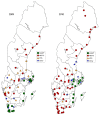Swedish emergency department triage and interventions for improved patient flows: a national update
- PMID: 22151969
- PMCID: PMC3285084
- DOI: 10.1186/1757-7241-19-72
Swedish emergency department triage and interventions for improved patient flows: a national update
Abstract
Background: In Scandinavia, emergency department triage and patient flow processes, are under development. In Sweden, the triage development has resulted in two new triage scales, the Adaptive Process Triage and the Medical Emergency Triage and Treatment System. Both these scales have logistic components, aiming to improve patient flows. The aim of this study was to report the development and current status of emergency department triage and patient flow processes in Sweden.
Methods: In 2009 and 2010 the Swedish Council on Health Technology Assessment sent out a questionnaire to the ED managers in all (74) Swedish hospital emergency departments. The questionnaire comprised questions about triage and interventions to improve patient flows.
Results: Nearly all (97%) EDs in Sweden employed a triage scale in 2010, which was an increase from 2009 (73%). Further, the Medical Emergency Triage and Treatment System was the triage scale most commonly implemented across the country. The implementation of flow-related interventions was not as common, but more than half (59%) of the EDs have implemented or plan to implement nurse requested X-ray.
Conclusions: There has been an increase in the use of triage scales in Swedish EDs during the last few years, with acceleration for the past two years. Most EDs have come to use the Medical Emergency Triage and Treatment System, which also indicates regional co-operation. The implementation of different interventions for improved patient flows in EDs most likely is explained by the problem of crowding. Generally, more studies are needed to investigate the economical aspects of these interventions.
Figures
Similar articles
-
An updated national survey of triage and triage related work in Sweden: a cross-sectional descriptive and comparative study.Scand J Trauma Resusc Emerg Med. 2021 Jul 3;29(1):89. doi: 10.1186/s13049-021-00905-2. Scand J Trauma Resusc Emerg Med. 2021. PMID: 34217351 Free PMC article.
-
Triage in emergency departments: national survey.J Clin Nurs. 2005 Oct;14(9):1067-74. doi: 10.1111/j.1365-2702.2005.01191.x. J Clin Nurs. 2005. PMID: 16164524
-
A descriptive study of registered nurses' application of the triage scale RETTS©; a Swedish reliability study.Int Emerg Nurs. 2018 May;38:21-28. doi: 10.1016/j.ienj.2017.12.003. Epub 2018 Jan 8. Int Emerg Nurs. 2018. PMID: 29326039
-
Improving assessment of acute obstetric patients - introducing a Swedish obstetric triage system.BMC Health Serv Res. 2021 Nov 6;21(1):1207. doi: 10.1186/s12913-021-07210-9. BMC Health Serv Res. 2021. PMID: 34742302 Free PMC article. Review.
-
Review of triage reform: the case for national consensus on a single triage scale for clients with a mental illness in Australian emergency departments.J Clin Nurs. 2010 Mar;19(5-6):712-5. doi: 10.1111/j.1365-2702.2009.02988.x. J Clin Nurs. 2010. PMID: 20500313 Review.
Cited by
-
Development of outcomes for evaluating emergency care triage: a Delphi approach.Scand J Trauma Resusc Emerg Med. 2023 Feb 25;31(1):10. doi: 10.1186/s13049-023-01073-1. Scand J Trauma Resusc Emerg Med. 2023. PMID: 36841783 Free PMC article.
-
Association between triage level and outcomes at Médecins Sans Frontières trauma hospital in Kunduz, Afghanistan, 2015.Emerg Med J. 2022 Aug;39(8):628-633. doi: 10.1136/emermed-2020-209470. Epub 2021 Nov 10. Emerg Med J. 2022. PMID: 34759014 Free PMC article.
-
Comparison of the novel WEst coast System for Triage (WEST) with Rapid Emergency Triage and Treatment System (RETTS©): an observational pilot study.Int J Emerg Med. 2022 Sep 12;15(1):47. doi: 10.1186/s12245-022-00452-2. Int J Emerg Med. 2022. PMID: 36096726 Free PMC article.
-
Addition of the clinical frailty scale to triage tools and early warning scores improves mortality prognostication at 30 days: A prospective observational multicenter study.J Am Coll Emerg Physicians Open. 2024 Sep 9;5(5):e13244. doi: 10.1002/emp2.13244. eCollection 2024 Oct. J Am Coll Emerg Physicians Open. 2024. PMID: 39253302 Free PMC article.
-
A longitudinal, retrospective registry-based validation study of RETTS©, the Swedish adult ED context version.Scand J Trauma Resusc Emerg Med. 2022 Apr 15;30(1):27. doi: 10.1186/s13049-022-01014-4. Scand J Trauma Resusc Emerg Med. 2022. PMID: 35428351 Free PMC article.
References
-
- Guidelines on the implementation of the Australasian triage scale in emergency departments. http://www.acem.org.au/media/policies_and_guidelines/G24_Implementation_...
MeSH terms
LinkOut - more resources
Full Text Sources
Miscellaneous


